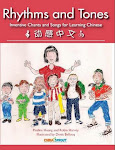Bethann Buddenbaum is a freelance consultant who moved back to her home state in the Midwest after living in Los Angeles for over 20 years. She is the mother of two daughters who were adopted from the Zhuzhou Social Welfare Institute in Hunan, China.
One of the hobbies that our family enjoys is cooking. It's a good way to work on math concepts, spend quality time together, and enjoy the fruits of our labor. The girls love to try new Chinese recipes, so every few weeks, we pull out one of our Chinese cookbooks and explore.
Whole steamed fish is one of our favorite recipes. It's easy and tasty, and we know it so well that we don't require a cookbook anymore. Whole steamed fish is most often associated with Chinese New Year as the Chinese word for fish (Yu-鱼) sounds like the Chinese word meaning abundance. Thus, serving whole steamed fish symbolizes wishes for abundance in the new year.
Sourcing Fish:
Although access to the local Chinatown is typically limited to major metropolitan cities, there are many cities that now have Asian markets where you can find live fish. It is best to use the freshest fish possible. However, if live fish is either not available or personally palatable, you can use fish from the fish market or grocer's fish section. Again, the preference is for whole fish over fillets and fresh versus frozen. The Chinese typically serve steamed fish whole, which means face and all. Some people (including my father) find "food with a face" unappealing. If you're one of these people, you can cut off the head during preparation or ask your butcher to do it for you at the store.
Most often, when we ordered whole steamed fish in Chinese restaurants in Los Angeles, we were served rock cod or bass. We prefer to avoid Atlantic cod and Chilean sea bass for environmental reasons, and in cooking this meal for ourselves, we have enjoyed other fish including tilapia, Pacific halibut, farmed striped bass, and yellowtail snapper.
Equipment:
- Cutting board
- Knife
- Fish steamer; or
- Alternatively if you do not have a fish steamer, you can use a large wok or deep pan and set an inverted baking dish or heat proof plate inside (see photo for example). If your whole fish will not fit inside, you can cut the fish in half.
- Small saucepan
Ingredients:
- 1 whole fish (1-1/2 to 2-1/2 pounds cleaned and dried thoroughly with head left on)
- 1-1/2 teaspoon sea salt
- 1/4 teaspoon sugar
- 5 scallions (white bottoms chopped and green tops cut into 2" sections and then silken threads)
- 1" fresh ginger root (peeled and cut into silken threads)
- 2 stalks lemongrass (cut into silken threads)
- 4 tablespoons soy sauce
- 1 tablespoon sesame oil
- 5 tablespoons peanut or corn oil
Preparation:
- Cut up the scallions, ginger root, and lemongrass.

- Slice open the fish at the belly (if purchased live and butcher did not do this).
- Clean and dry the fish.

- Make 3 diagonal slashes on both sides of the fish.
- Mix together 1 teaspoon sea salt with all of the white cut scallions, half of the ginger root and lemongrass, and 2 tablespoons of the peanut or corn oil.
- Stuff the cavity of the fish with half of the seasoning mixture, and place the seasoned fish in the refrigerator for 30 to 60 minutes.

- Place the other half of the seasoning mixture on the steamer tray or heatproof dish.

- Place fish into the steamer on the bed of the seasoning mixture.
- Steam over medium heat for 10 to 15 minutes, until the fish is thoroughly cooked and flakes easily with a fork.
- Remove the fish from the steamer.
- Discard the cooked seasonings and move fish to serving plate.
- Warm soy sauce, sugar, sesame oil, and 1/2 teaspoon sea salt in a saucepan and pour over fish.
- Heat 3 tablespoons of peanut or corn oil in a saucepan over high heat until smoke rises. Add the remaining ginger, a portion of the green scallion and lemongrass (keeping some back for garnish) and heat for 10 to 15 seconds. Pour this hot oil and seasoning mixture over the fish.
- Place remaining scallion and lemongrass threads on fish for garnish and serve immediately.
- Do not boil on high heat as this can cause tearing of the fish flesh. Cook fish at a slow, medium boil.
- You can create a nice garnish with the scallion greens by placing them in a bowl of ice water until the threads curl.
- Use soy sauce to taste. We actually prefer more soy sauce on our fish, and also like to add Shaoxing wine to our soy sauce mixture.











